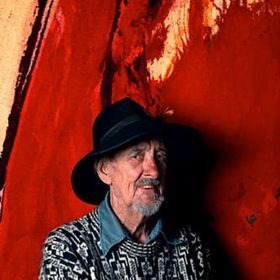signed in the weave lower right
PROVENANCE:
Edinburgh Tapestry Company (Dovecot Studios, Edinburgh)
A maverick talent of exuberant gifts, Sax Shaw was one of the most dynamic forces in post-war Scottish art and design. The Little Foxes, created around 1955, stands among his most dazzling and inventive achievements,
a tapestry alive with movement, colour, and metaphor. At its centre, lithe, dancing foxes twist and turn in rhythmic formation, their elongated forms and swishing tails creating a sense of balletic motion, flickering like flames. Shaw surrounds them with decorative flame motifs and a structured border of birds woven in a palette of red, orange, grey, and black. The entire composition sings with theatricality and formal precision, a woven ballet of folklore and abstraction.
Shaw was born in Berry Brow, Yorkshire, in 1916 and trained at Huddersfield School of Art before choosing to study at Edinburgh College of Art, where he found a thriving stained-glass department. Though offered
a place at the Royal College of Art, London, Shaw was drawn to Edinburgh’s commitment to architectural design and contextual craftsmanship. Following wartime service as a conscientious objector, he returned to Edinburgh College of Art and began working in theatre design, tapestry, and stained glass, often in collaboration with his wife, Maisie Mallinson.
In 1947–48, Shaw visited Paris on a scholarship and was welcomed into the Gobelins tapestry studios, experiences that would shape his approach to weaving and solidify his belief in the artistic role of the designer-weaver. His subsequent appointment in 1953 as Director of Weaving at The Edinburgh Tapestry Company (now Dovecot Studios) marked the beginning of a radical shift in British tapestry, as Shaw championed a modern, expressive use of texture, narrative, and abstraction. The Little Foxes, with its layered symbolism, rich colour, and fluid design, is a landmark work of this period.
As a teacher at Edinburgh College of Art from 1948 to 1981, and as a visiting lecturer across Scotland, Shaw shaped generations of designers and stained-glass artists. Shaw’s work ranged across disciplines – tapestry, stained glass, mural painting, mosaics, church furnishings, watercolour, and costume design, yet his voice remained unmistakable; playful, rigorous, spiritual, and deeply embedded in the life of buildings and spaces.
The Little Foxes captures the essence of his mid-century vision, modern yet mythical, formal yet free. It remains a triumph of narrative design, where flame, fur, and folklore are transformed into woven movement and enduring light.

Sax Shaw was born in Berry Brow, Yorkshire, in 1916 and trained at Huddersfield School of Art before choosing to study at Edinburgh College of Art, where he found a thriving stained-glass department. Though offered a place at the Royal College of Art, London, Shaw was drawn to Edinburgh’s commitment to architectural design and contextual craftsmanship. Following wartime service as a conscientious objector, he returned to Edinburgh College of Art and began working in theatre design, tapestry, and stained glass, often in collaboration with his wife, Maisie Mallinson. In 1947–48, Shaw visited Paris on a scholarship and was welcomed into the Gobelins tapestry studios, experiences that would shape his approach to weaving and solidify his belief in the artistic role of the designer-weaver. His subsequent appointment in 1953 as Director of Weaving at The Edinburgh Tapestry Company (now Dovecot Studios) marked the beginning of a radical shift in British tapestry, as Shaw championed a modern, expressive use of texture, narrative, and abstraction.
As a teacher at Edinburgh College of Art from 1948 to 1981, and as a visiting lecturer across Scotland, Shaw shaped generations of designers and stained-glass artists. Shaw’s work ranged across disciplines – tapestry, stained glass, mural painting, mosaics, church furnishings, watercolour, and costume design, yet his voice remained unmistakable; playful, rigorous, spiritual, and deeply embedded in the life of buildings and spaces.